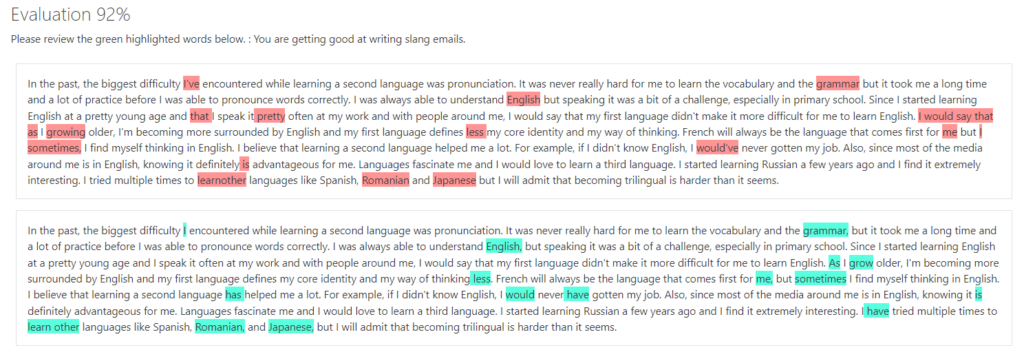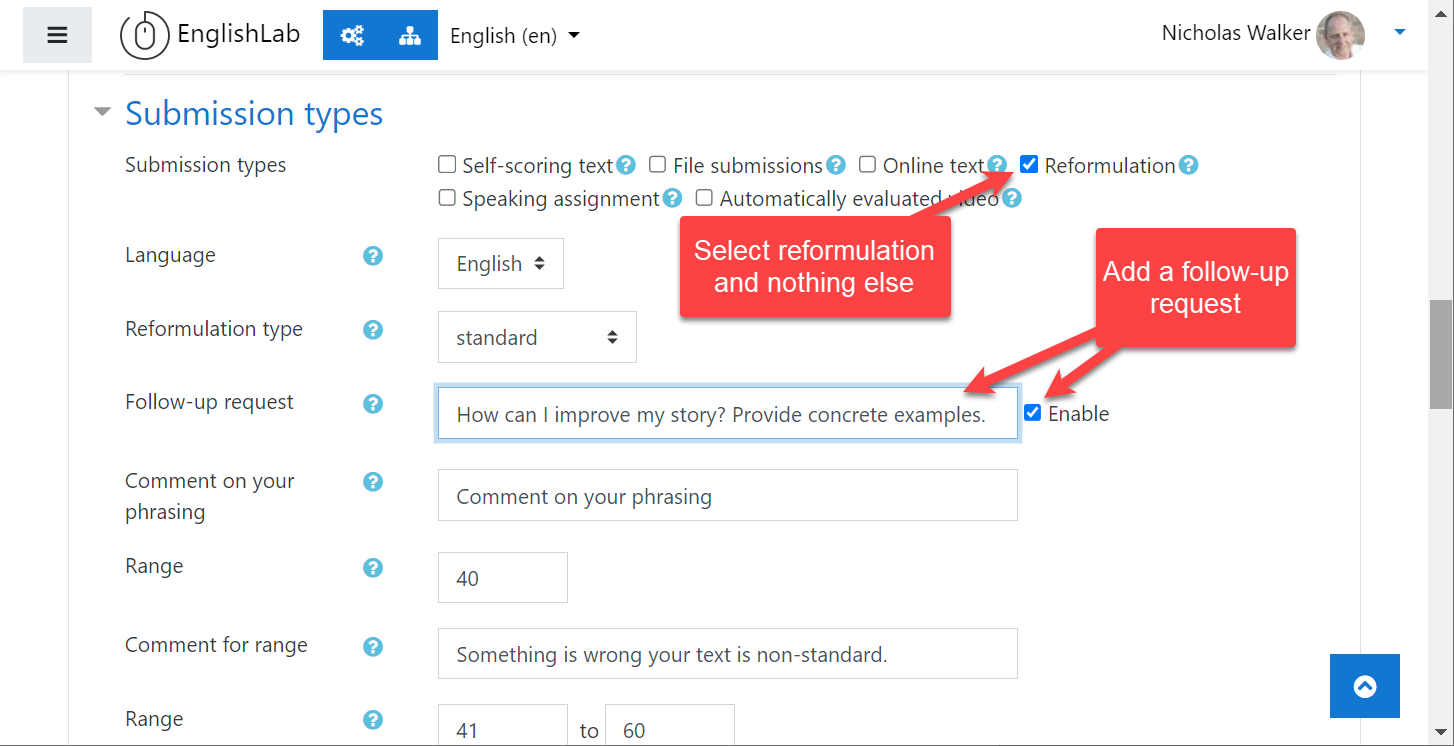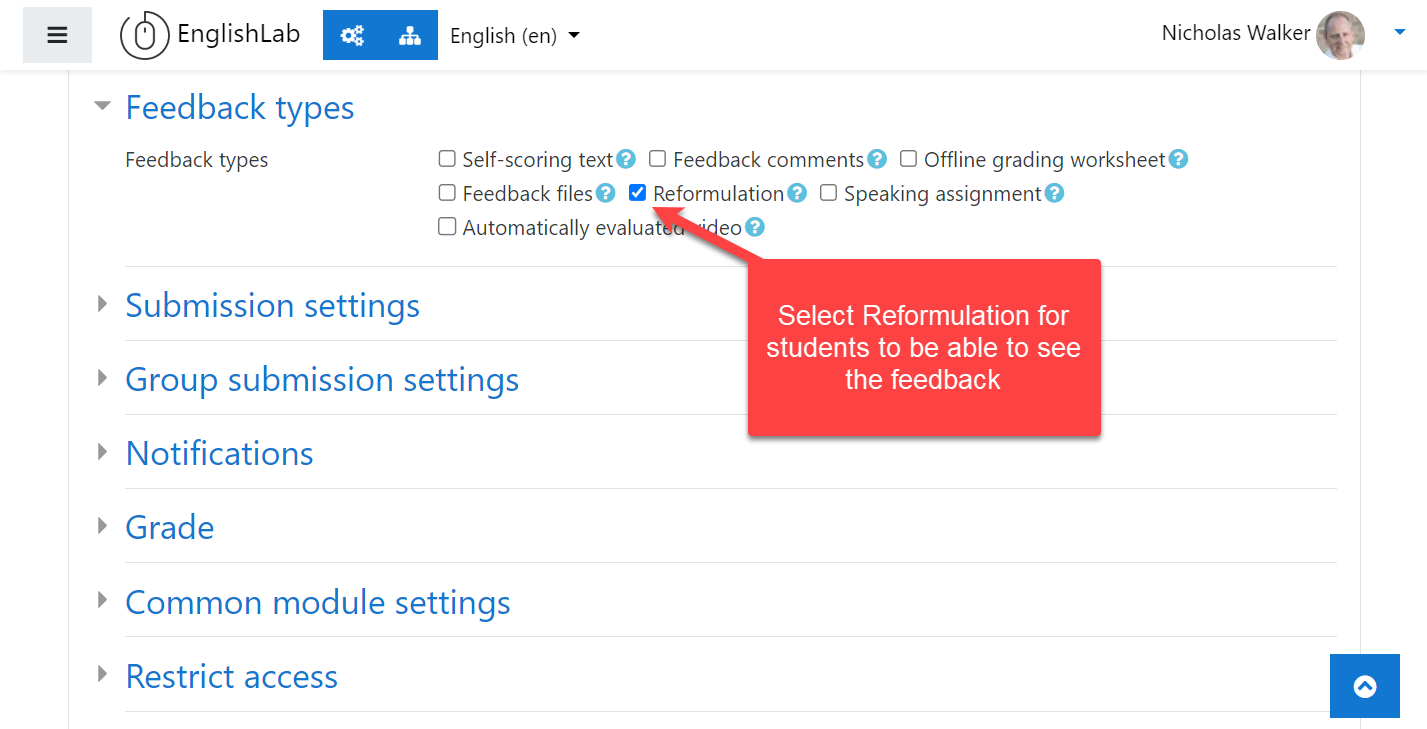
AI-Powered Courses
You can create an AI-powered second language course that your students will love. AI is big and getting bigger. AI-powered courses are the future because they give teachers superpowers to develop meaningful lessons, correct errors, and respond to students’ ideas at a level never considered possible before. Don’t get left behind.
If you are comfortable with new forms of language pedagogy, jump straight to the two AI-powered turnkey projects here.
AI means change
With AI-powered courses, teaching can shift from preparing and correcting to coaching and supervising. Your courses are going to change for the better. Your workload will reduce dramatically, and you’ll get to reflect on the opportunity AI affords in terms of pedagogy. There’s just a little technology to learn, but it is easy to master.
First, let’s set some goals for the new age of AI-powered courses. One goal should be to avoid the stress of overwork. AI allows teachers to keep our workload under control. Next, let’s make our courses as social and communicative as possible. We don’t need long long vocabulary lists and grammar rules. Let’s keep teacher talk to a minimum and let our students do the talking. Also, let’s not ignore the context of the classroom and pretend we are at the post office or a restaurant. Let’s be fully present in the classroom and use icebreakers, interviews, games, and storytelling to engage and entertain each other. Let’s make every week as social and communicative as Week 1.

As the comic strip illustrates, it’s easy to lose momentum in a language course. Week 1 starts off great with the social goal of getting to know each other. Week 2 is different. The course becomes heavy with a language focus and communication becomes an afterthought. The linguistic focus drains the joy out of the class. Let’s fix that with AI. Let’s give every week a communicative goal.
How? Let’s hide the grammar and use a creative writing project to focus of our lessons and conversations. That’ll mean a lot more writing assignments for students, but a lot less correction work for the teacher.
Hide the grammar
Let’s never mention grammar to the students. It’ll be our secret. Instead, let’s focus on communicative functions. For example, instead of saying, “This week, we are going to learn the Present Simple,” we could tell students, “This week we are going to focus on coordinating plans with people despite a busy schedule. For example, here’s what we could say to a friend or co-worker: I can’t meet you on Saturday because I work on the weekend.” When we focus on what to say in particular contexts, multiple grammar points arise at the same time. Let’s teach with examples instead of rules.
One problem with switching to communicative functions while trying to preserve the usual sequence of the grammar curriculum is that lessons will seem disconnected to students. But there’s an easy solution for incoherent courses.
Incoherent courses
To teachers, a grammar course is perfectly coherent. We start with Present Simple and Present Progressive, past tenses and the Present Perfect, and then end the semester with future tenses and modals. But the sequence doesn’t make sense to students in terms of the sequence of their communicative needs. Why do teachers always begin a course with present tenses and end with modals? Why not begin a course with modals when it makes sense to discuss some ground rules, what students and teachers should do in class, must do for homework, and can do to improve our grades?
Compounding the problem, after covering a wide range of grammar points, college teachers often ask students to write essays which cannot elicit the range of grammar that was taught. Students end up scratching their heads and asking, “Why did we study those tenses if they weren’t needed in the final competency evaluation? Just in case? I don’t like English. There’s too much useless baggage.”
I agree. ESL courses would benefit from a tighter linguistic focus on the language needed for the assignments that count.
Narrative writing projects
Let’s be honest. No student walks into a course and asks to study a list of grammar points and alphabetical lists of vocabulary. Students want to be able to do things with the language. They want communicative functions that they can use immediately in the classroom and beyond its walls.
Narrative writing projects create an immediate communicative need. Students say to themselves, “If I am going to tell this story, I need to know how to say X and Y. Teacher, I have a question.”
Narrative writing projects also generate a communicative need that makes sense in the classroom context: school can be dull, so let’s entertain each other and make each other laugh! You don’t have to pretend to be at a restaurant or roleplay sending a parcel at the post office. The imaginative pretending is baked into storytelling, and the communicative need is self-evident: entertain me!
Furthermore, narrative projects can help teachers sequence lessons, making the course more coherent and cohesive. How? Narrative writing projects facilitate the shift from just-in-case grammar lessons to just-in-time lessons: you only need to teach the target structures (grammar, vocabulary, and phrases) needed in time for this week’s writing task.
You will actually be able to cover all of the same grammar but in a slightly different order. For example, when we write a story using first-person narrative, we’ll want to start by describing our fictional character. For that, they could elicit the Present Simple (I live here, and I work there) and Present Progressive (I’m wearing this), adjectives (I’m tall, and people say look like a movie star). Stories contain all of the grammar of the language. Stories are how we learn the verb system of any language without having to be taught grammar. Stories charm and communicate on multiple levels with every repetition.
Play-by-post
Week 1 was great. There were icebreakers and getting to know you activities. To follow upon the social aspect of Week 1, in Week 2 you can introduce a play-by-post writing project. What’s play-by-post? It’s a narrative game that real people play in the real world. Play-by-post (PbP) refers to a style of interactive storytelling or role-playing game (RPG) in which participants collaboratively create a narrative by taking turns posting text-based messages in a dedicated forum. (We’ll use Labodanglais.com’s assignment module.)
In play-by-post narratives, participants typically assume the roles of characters within a fictional setting, and the story evolves through their interactions and written descriptions. Each player writes from the perspective of their character, narrating their actions, thoughts, and dialogue. The narrative can be structured with sections, allowing for the progression of the story and the development of individual character arcs.
Play-by-post offers the opportunity for collaborative storytelling with multiple perspectives and ideas. It encourages creativity, writing skills, and imaginative problem-solving, as players must think critically and adapt to the evolving narrative. Overall, play-by-post is a dynamic and engaging way for individuals to participate in shared storytelling experiences, fostering collaboration, creativity, and community-building among players.
In a classroom setting, play-by-post projects work well when each weekly lesson tackles one chapter in a series of predetermined chapters. The writing prompt will be the same for everyone in the class, but each writing group will agree on shared story elements unique to their group. For example, the group will agree on the setting, common problems, and every student in the group will include the other student’s characters in their own story. This will reduce the urge to cheat. A story with no evidence of input from the other students in the group is a sign of GPT-enabled academic fraud.
While the each student’s story will share elements of their groupmates’ stories, each student’s story will be worded differently because each student tells the story from the perspective of his or her own character. Each week, group members will arrive in class with a new chapter to entertain and delight their group with. You can encourage the competitive drive of students by requiring group members to vote on who has the best story, and share what made it the best with the whole class.
AI-powered corrections
Normally, a teacher would want to ask students to write 10 sections of a play-by-post story over 10 weeks. With a 150 students, that’s a 1500 texts to correct. If you spend 10 minutes correcting each text, that will generate 250 hours of corrections. Yikes! Let’s get Labodanglais to help with that. We’ll use the AI Reformulation and Reply Assignment to give feedback and a score. The students will get the practice they need, and teachers will be able to enjoy their evenings and weekends.

The system calculates a score by reformulating the student’s writing using a Large Language Model (LLM) like Chat GPT. In other words, the system takes broken English and turns it into standard English. It scores the text by comparing how different the standardized version is to the text the student submitted. It then highlights the non-standard parts of the submitted text in red and highlights the corrections in green. Scores will tend to be higher than you might ordinarily give students because the differences between two texts tend to be minimal (a missing -s, a missing capital letter, a different preposition) when compared to the total length of the text.

The system also provides personalized AI coaching comments to the student, telling him or her how to improve the story or argument. The student can continue to revise and improve their texts until they are satisfied with the result. No teacher would be able to provide thousands of corrections with coaching on an unlimited number of drafts. Since the system saves students’ scores to the grade book, the system tracks students’ progress. All you have to do as the teacher is supervise the robot the way you supervise your dishwasher. It’s better pedagogy with a fraction of the work.
Writing assignments are simple to set up. Simply, check the “Reformulation” checkbox in the assignment submission and feedback settings list and add this instruction to the follow-up box. Here are the steps.
For orals, use the automatically scored video assignment so that students get oral practice and feedback on their pronunciation by using their webcams. Students read their stories aloud while recording, and the system uses the most robust speech recognition system available on the web today to transcribe what they say. If the transcription doesn't match the text they read, the student has pronunciation errors that require attention.Step 1: add an assignment

Step 2: set the due dates

Step 3: select Reformulation only in the Submission types settings

Step 4: select Reformulation only in the Feedback types settings

If you can fill out a form online, you can create a series of AI-powered assignments.
Two projects
Here are two short examples of play-by-post projects. The first is called “The Chronicles of Academia” and is suitable for an intermediate English Second Language course. The second example is for courses that aim to help students prepare for the workplace. Jump to the workplace example by clicking here.
The Chronicles of Academia
This “Chronicles of Academia” project was created with the help of ChatGPT here. Download the entire project with sample discussion questions here. You can generate more ideas for discussion questions and model answers using Chat GPT. A course with all ten sections of the story and AI evaluations ready to give to your students is here. Contact me to make it your own.
Part 1: the characters
We’ll tell students that each one of them will create a character based on themselves with some peculiar quality that makes them unusual: magic, superpowers, technological prowess, unlimited wealth, gender fluidity, or a hidden talent. In class, we can provide just-in-time models of descriptive adjectives and other descriptive language. Here’s the first writing prompt and here’s a model with a glossary to inspire students.
The story begins as your characters prepare for their first day of school. Your character gets dressed in the full length mirror and notices clothing, hair, and other distinguishing features. Meanwhile, your character worries about how he or she will fit in since he or she is peculiar in some way. Describe the morning using interior monologue.
Every member of the group will submit their own section of the story on Labo, to be scored by the AI Reformulation and Reply Assignment. The system will give a score, show corrections, and provide personalized AI coaching comments. Ask them to identify topic-related vocabulary, and add terms and definitions to a shared glossary project on Labo.
Part 2: the setting
The following week, the extraordinary fictional characters will attend a school that looks just like their own, but it is mysterious and dangerous in some exciting way. Send your students out to explore the school. In the process, they must take a photo of a feature of the school that they imagine has a mysterious or sinister secret purpose. (Secret grammar focus: prepositions and descriptive langauge.)
The story continues as your characters, freshly admitted to the esteemed Academy of Knowledge, arrive on campus. Explore the sprawling institution, meet your classmates, and navigate the labyrinthine halls to find your place within this new environment. Your first challenge awaits!
Part 3: the quest for wisdom
We are now in Week 4, section 3 of the project.
A legendary artifact, said to bestow unparalleled wisdom upon its wielder, has gone missing from the library’s restricted archives. Uncover clues, solve riddles, and embark on a thrilling adventure to retrieve the artifact while encountering magical creatures, secret societies, and academic puzzles.
Parts 4-10
Download the rest of the PbP project here. A course with all ten sections of the story and AI evaluations ready to give to your students is here. Contact me to make it your own.
The Office Chronicles
This “Workplace Chronicles” project was created with the help of ChatGPT here. Download the entire project here. You can generate more ideas for discussion questions and model answers using Chat GPT. A course with all ten sections of the story and AI evaluations ready to give to your students is here. Contact me to preview it.
Part 1: the characters
“As the newest member of the office, describe your first day at work, your impressions of your colleagues, and your fears and expectations. Write about the challenges you face in trying to fit in, the ways you try to understand the dynamics, and how you see yourself growing in this environment.”
Part 2: the conflict
“In the midst of a heated meeting, your closest ally at work disagrees with you on a crucial point. Chronicle the internal turmoil this causes, the confrontations that follow, and how this impacts your relationship. Explore the changes you both undergo, and the lessons you learn about trust and professionalism.”
Part 3: alliances
“You have been given a difficult task, one that requires you to work closely with a colleague you dislike. Write about your initial reluctance, the struggles you face in the process, and how you both overcome personal differences to accomplish the goal.”
Parts 4-10
Download the rest of the PbP project here. A course with all ten sections of the story and AI evaluations ready to give to your students is here. Contact me to make it your own.
